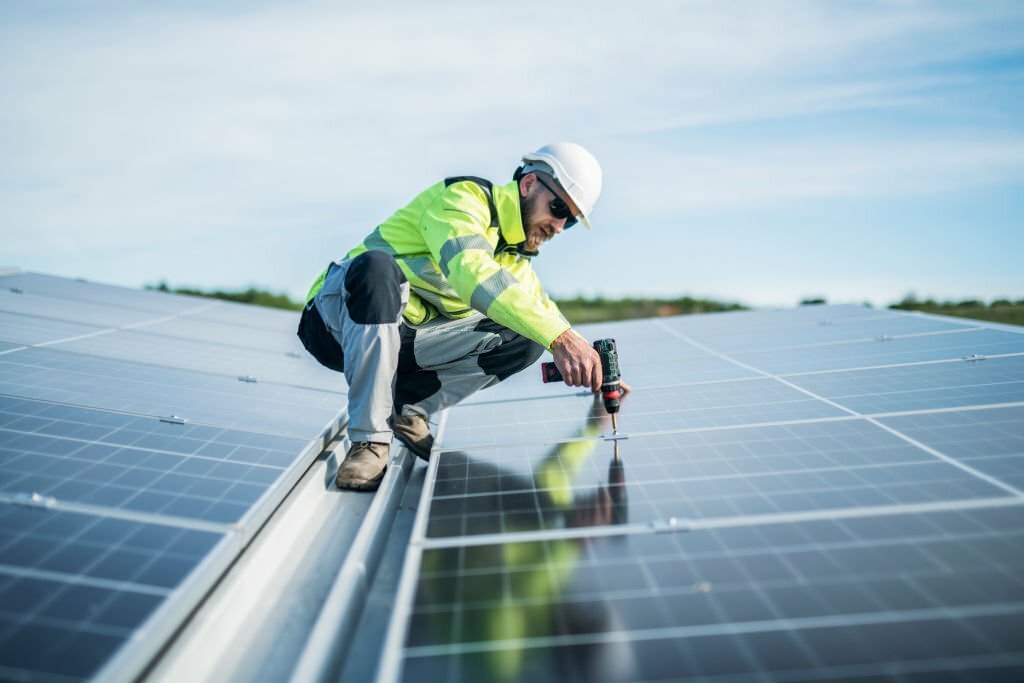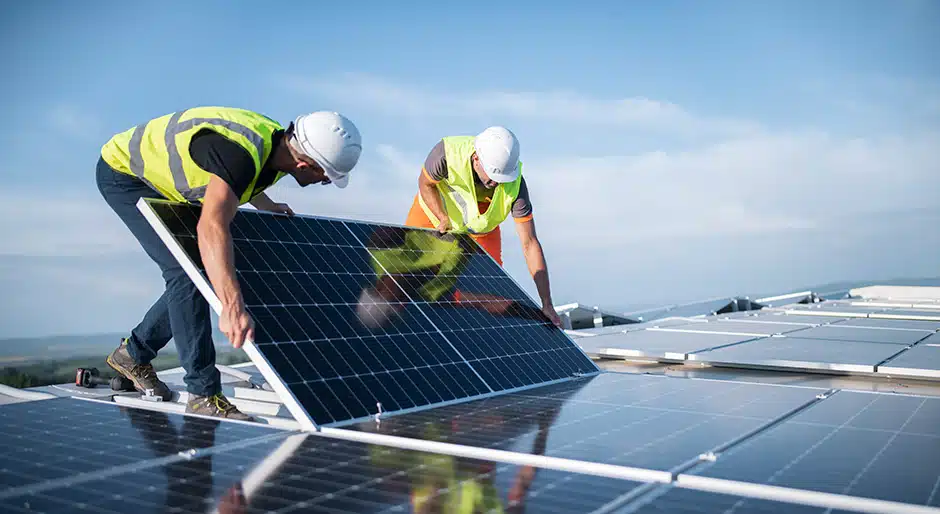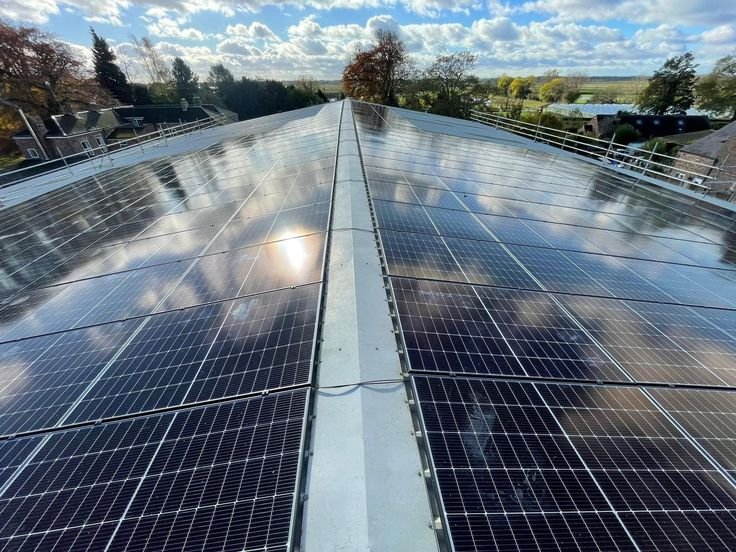India, a country with abundant sunshine for most of the year, is rapidly emerging as a leader in the global renewable energy sector. Among the various sustainable solutions, rooftop solar in India is revolutionizing the way we produce and consume electricity. Rooftop solar systems are not only transforming households and commercial buildings into self-sufficient energy producers, but they’re also playing a vital role in achieving India’s ambitious renewable energy goals.
Table of Contents
This blog dives deep into the current scenario, benefits, challenges, government initiatives, installation processes, and the promising future of rooftop solar India. Whether you’re a homeowner, business owner, or policymaker, this comprehensive guide will provide all the essential insights you need.
What is Rooftop Solar?
Rooftop solar in India refers to the installation of solar photovoltaic (PV) systems on the rooftops of buildings such as homes, businesses, factories, and government institutions. These systems harness the power of the sun to generate electricity, offering a sustainable and renewable alternative to traditional energy sources.
The Growing Demand for Rooftop Solar in India
Rooftop solar installations in India have seen a remarkable surge in recent years, driven by a combination of environmental consciousness, government incentives, and rising electricity costs. As India continues its push toward renewable energy, rooftop solar has become one of the most viable and attractive solutions for both residential and commercial sectors.
In fiscal year 2025, India added 23.8 GW of new solar capacity, a 58.5% increase from the previous year, driven by utility-scale projects, rooftop installations under the PM Surya Ghar: Muft Bijli Yojana, and off-grid solutions. As of January 2025, the Western regions led with 59% of installations, followed by the South (21%), North (14%), Central (4%), East (2%), and Northeast (0.005%). Projections suggest India’s solar capacity could double to 30 GW in 2025, aligning with the goal of achieving 500 GW of renewable energy by 2030. However, challenges like land disputes and financial issues among state-owned companies could affect progress, making it crucial to address these obstacles for sustained growth.
Advantages of Rooftop Solar in India
1. Cost Savings: Installing solar panels can lead to substantial savings on electricity costs. A 5kW solar system, for instance, can generate around 600 units monthly, potentially saving approximately ₹4,200 each month.
2. Environmental Benefits: Solar energy is clean, renewable, and reduces greenhouse gas emissions, helping combat climate change and contributing to a cleaner environment.
3. Energy Independence: By generating electricity on your rooftop, you reduce reliance on the grid, offering greater energy security and minimizing power outages.
4. Government Subsidies: The Indian government provides various subsidies and financial incentives, such as the Pradhan Mantri Surya Ghar Muft Bijli Yojana, making rooftop solar more affordable.
5. Increased Property Value: Homes with solar installations often see an increase in property value due to energy efficiency and reduced utility costs.
6. Grid Suppor: Rooftop solar helps stabilize the grid by reducing transmission losses and improving overall power distribution.
7. Sustainability: Rooftop solar contributes to India’s renewable energy targets, supporting the nation’s goal of achieving 500 GW of renewable energy capacity by 2030.

Key Components of a Rooftop Solar System
Understanding the major components is essential for anyone interested in rooftop solar India:
- Solar Panels: Capture sunlight and convert it into direct current (DC).
- Inverter: Converts DC into alternating current (AC), which powers appliances.
- Mounting Structures: Hold the panels at the right angle for maximum sunlight exposure.
- Batteries (optional): Store excess energy for use during non-sunny hours.
- Net Meter: Measures the energy consumed from and supplied to the grid.
Types of Rooftop Solar in India
There are primarily three types of rooftop solar systems popular in India:
1. Grid-Tied Solar Systems
This is the simplest and most cost-effective system to install. Here, the system is grid-connected and does not have energy storage. The net meter records the number of units exported and imported. This allows you to receive credit for excess power exported to the grid. On grid solar systems are especially useful in cases where there is a stable grid connection. It is easy to maintain, cost effective and easy to install.
2. Off-Grid Solar Systems
Off Grid Solar System requires battery storage as it as it is not connected to electricity grid. An off-grid system requires battery storage and is not connected to the electricity grid. In these a solar technician needs to design a system in such a way that has enough power generation and battery storage to meet the home’s requirements even in the depths of winter when there is no or little sunlight. Off-grid systems are comparatively more expensive than on-grid system because of the high cost of batteries and usually found only in remote areas that are far from any electricity grid. As battery costs are declining there is a growth in the market for battery storage.
3. Hybrid Solar Systems
Hybrid solar power systems combine the benefits of both on-grid and off-grid solar solutions. They store power generated during the day and use it at night, providing a backup power when the grid is unavailable. When the battery system is fully charged and electricity is used, the excess power is sent to the grid for credit, reducing the consumer’s electricity bill. This system allows consumers to have the best of both worlds, with the grid serving as a backup when the battery system is fully charged.
Rooftop Solar India: Market Segments
1. Residential Sector: New installations are largely driven by government initiatives like PM Surya Ghar: Muft Bijli Yojana, which provides subsidies and streamlines homeowner processes.
2. Commercial Sector: Shops, malls, and office buildings are investing in rooftop solar to cut operating costs and enhance sustainability credentials.
3. Industrial Sector: Industries are the largest consumers of electricity and thus find rooftop solar to be an economically viable solution for long-term savings.
4. Educational and Government Institutions: Schools, colleges, and government offices are increasingly adopting rooftop solar India initiatives for cost savings and environmental responsibility.
Government Initiatives Supporting Rooftop Solar in India
1. PM Surya Ghar Yojana
Launched in February 2024, this flagship scheme aims to solarize 10 million households by 2027. It offers subsidies of up to ₹30,000 per kW for systems up to 2 kW and ₹78,000 for systems of 3 kW or higher. Beneficiaries can receive up to 300 units of free electricity per month, potentially saving ₹15,000 annually.
2. PM Kusum Scheme
Targeted at the agricultural sector, the Pradhan Mantri Kisan Urja Suraksha evam Utthaan Mahabhiyan (PM-KUSUM) scheme facilitates the installation of solar pumps and grid-connected solar power plants for farmers. It aims to reduce farmers’ dependence on diesel and grid electricity, promoting sustainable agriculture.
3. Grid-Connected Rooftop Solar Programme (MNRE Phase II)
Managed by the Ministry of New and Renewable Energy (MNRE), this program aims to achieve 40 GW of rooftop solar capacity by March 2026. It provides subsidies for residential installations and supports state-level distribution companies in promoting rooftop solar in India adoption.

Steps to Install Rooftop Solar in India
Here’s a step-by-step guide to installing a rooftop solar system:
- Site Assessment: Evaluate roof size, shading, and orientation.
- Load Analysis: Determine daily electricity consumption.
- System Design: Choose system capacity and type (grid-tied/off-grid/hybrid).
- Vendor Selection: Contact MNRE-registered vendors for quotes and technical evaluation.
- Installation: Panels, inverter, wiring, and net meter installation.
- Inspection & Approval: Local DISCOMs inspect the setup before granting net metering approval.
- Monitoring: Use apps or portals to track performance and energy savings.
Top States Leading in Rooftop Solar in India
1. Gujarat
Installed Capacity: Approximately 4,984 MW (as of January 2025)
Highlights:
- Initiatives like the Surya Gujarat scheme have been instrumental in promoting residential solar adoption.
- Gujarat leads the nation in rooftop solar installations, accounting for over half of the western region’s capacity.
- The state benefits from robust policy support and high public adoption rates.
2. Maharashtra
Installed Capacity: Approximately 3,034 MW
Highlights:
- The state’s commercial and industrial sectors have significantly contributed to this growth.
- Maharashtra ranks second in rooftop solar capacity, driven by substantial adoption in urban centers such as Mumbai and Pune.
3. Rajasthan
Installed Capacity: Approximately 1,483 MW
Highlights:
- Rajasthan’s vast desert terrain and high solar irradiance make it ideal for solar energy projects.
- The state has developed large-scale solar parks, including the Bhadla Solar Park, one of the largest globally.
4. Tamil Nadu
Installed Capacity: Approximately 1,374 MW
Highlights:
- Tamil Nadu has a well-balanced approach to both solar and wind energy, contributing to its substantial rooftop solar capacity.
- The state has implemented policies to encourage solar adoption across residential and commercial sectors.
5. Karnataka
Installed Capacity: Approximately 1,098 MW
Highlights:
- Karnataka has cultivated vast solar infrastructure, with a focus on both utility-scale and rooftop installations.
- The state’s commitment to renewable energy is evident through its large solar farms and distributed solar projects.
Financing Options for Rooftop Solar in India
1. PM Surya Ghar: Muft Bijli Yojana (2024)
Launched by the Government of India, this scheme aims to solarize 1 crore households by 2027. It provides:
- Subsidies: Up to ₹78,000, depending on system capacity.
- Free Electricity: Beneficiaries can receive up to 300 units per month.
- Concessional Loans: Available through participating banks
Applications can be made via the official portal: pmsuryaghar.gov.in. Wikipedia
2. Bank Financing Options
Several banks offer tailored loans for rooftop solar in India installations:
- State Bank of India (SBI): Offers loans under the “Surya Ghar” scheme with interest rates starting from 8.25% per annum.
- Bank of India (BOI): Provides loans up to ₹6 lakh for individuals and ₹100 lakh for housing societies, with interest rates starting at 7% per annum and no processing charges.
3. Non-Banking Financial Companies (NBFCs) and Specialized Lenders
Various NBFCs and solar financing companies offer flexible loan options:
- Electronica Finance Limited: Provides rooftop solar loans for residential properties, MSMEs, and institutions.
- Ecofy: Offers loans with interest rates ranging from 12% to 24%, depending on the borrower’s profile.
- Tata Power Solaroof: Partners with various financial institutions to offer loans with interest rates between 8.2% and 12% per annum, and tenures up to 5 years.
4. Housing Finance Integration
Some lenders allow borrowers to integrate solar loans with home loans or renovation loans, offering:
- Loan Amount: Up to 90% of the solar rooftop cost.
- Tenure: Up to 20 years when combined with housing loans.
- Interest Rates: Competitive rates based on the borrower’s credit profile.
5. Eligibility and Application
Eligibility criteria generally include:Ratnaafin – RBI registered NBFC
- Property Ownership: Legal ownership of the property where the solar system will be installed.
- Credit Score: A minimum CIBIL score of 670.
- Income Proof: Stable income sources for loan repayment.

Why Choose Soleos Solar for Rooftop Solar in India?
When it comes to rooftop solar in India, Soleos Solar Energy Private Limited stands out as a trusted name in delivering efficient, affordable, and sustainable energy solutions. Here’s why thousands of customers choose Soleos Solar:
1. Expertise and Experience: With years of industry experience, Soleos Solar has successfully implemented numerous rooftop solar in India projects across residential, commercial, and industrial segments in India.
2. Premium Quality Components: We use only Tier-1 solar panels, high-efficiency inverters, and durable mounting structures to ensure long-lasting performance and maximum energy output.
3. Customized Solutions: Every rooftop is different. We offer tailor-made solutions based on your energy needs, rooftop structure, and budget — maximizing both savings and sustainability.
4. Hassle-Free Installation: From site survey and system design to government approvals and net metering, Soleos Solar ensures a seamless installation process with minimal disruption to your daily life.
5. Transparent Pricing & Financing Support: Our solutions are cost-effective with clear pricing. Plus, we assist with subsidy claims and financing through our banking and NBFC partners to make your solar journey affordable.
6. After-Sales Service and Monitoring: Enjoy worry-free maintenance, real-time performance monitoring, and prompt customer support post-installation to keep your system running at its best.
7. Commitment to Sustainability: At Soleos, we’re not just installing solar systems—we’re driving India’s transition to clean energy and contributing to a greener planet, one rooftop at a time.
Rooftop Solar in India: The Road Ahead
The future of rooftop solar in India looks exceptionally promising as the country works toward its ambitious renewable energy goal of 500 GW by 2030, with 280 GW projected from solar power. Rooftop solar in India is set to play a pivotal role in achieving this target, especially with government programs like the PM Surya Ghar: Muft Bijli Yojana, which aims to add 30 GW of rooftop solar capacity in the residential sector, significantly supporting these efforts.
However, as of January 2025, only 16.28 GW of India’s total 100.33 GW solar capacity is derived from rooftop solar in India, showcasing the immense untapped potential. Despite this, rooftop solar in India is becoming more accessible due to reduced costs, technological advancements, and flexible financing options. This shift makes it increasingly feasible for both residential and commercial sectors to adopt solar energy solutions.
Cities and states are rising as leaders in this energy transition, but there are still challenges such as policy implementation and the financial health of distribution companies (DISCOMs) that need to be addressed. The future is clear: rooftop solar in India is transitioning from a mere trend to a nationwide movement for energy independence and climate resilience. For individuals and organizations alike, embracing rooftop solar in India is not just an opportunity but a necessary step toward a sustainable and self-sufficient future.
Conclusion
The landscape of rooftop solar in India is rapidly evolving, driven by ambitious government initiatives like the PM Surya Ghar: Muft Bijli Yojana, which aims to empower 1 crore households with solar energy and provide them with 300 units of free electricity every month . This initiative is a significant step toward realizing India’s renewable energy targets of 500 GW by 2030, with 280 GW expected from solar power.
Despite challenges such as policy implementation and the financial health of distribution companies (DISCOMs), the momentum for rooftop solar in India is building. The government’s streamlined processes and incentives are making it easier for residents to switch to clean energy, contributing to a cleaner and more sustainable future for the nation .
For individuals and institutions considering the transition, now is the opportune time to invest in rooftop solar in India. By doing so, you not only contribute to the country’s renewable energy goals but also benefit from reduced electricity bills and increased energy independence.
To take the first step toward adopting rooftop solar in India, visit the official portal to apply for subsidies and learn more about the installation process. Embrace the future of energy and be part of India’s solar revolution.
Frequently Asked Questions (FAQs)
Q1: What is the cost of a rooftop solar system in India?
The cost typically ranges between ₹45,000 to ₹65,000 per kW, depending on system type, brand, and location.
Q2: Is rooftop solar worth it in India?
Absolutely. With subsidies, net metering, and reduced electricity bills, rooftop solar is a highly cost-effective investment.
Q3: How much area is required for 1 kW of rooftop solar?
Approximately 100 square feet of shadow-free rooftop area is required for 1 kW installation.
Q4: Can I go off-grid with rooftop solar in India?
Yes, but you will need a battery backup system, which increases the initial cost.
Q5: How long does it take to recover the investment?
The payback period typically ranges from 3 to 5 years, depending on consumption and subsidies.
